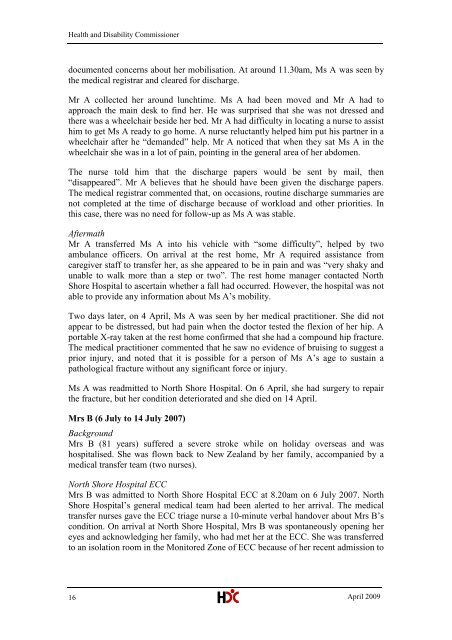North Shore Hospital report - New Zealand Doctor
North Shore Hospital report - New Zealand Doctor
North Shore Hospital report - New Zealand Doctor
You also want an ePaper? Increase the reach of your titles
YUMPU automatically turns print PDFs into web optimized ePapers that Google loves.
Health and Disability Commissionerdocumented concerns about her mobilisation. At around 11.30am, Ms A was seen bythe medical registrar and cleared for discharge.Mr A collected her around lunchtime. Ms A had been moved and Mr A had toapproach the main desk to find her. He was surprised that she was not dressed andthere was a wheelchair beside her bed. Mr A had difficulty in locating a nurse to assisthim to get Ms A ready to go home. A nurse reluctantly helped him put his partner in awheelchair after he ―demanded‖ help. Mr A noticed that when they sat Ms A in thewheelchair she was in a lot of pain, pointing in the general area of her abdomen.The nurse told him that the discharge papers would be sent by mail, then―disappeared‖. Mr A believes that he should have been given the discharge papers.The medical registrar commented that, on occasions, routine discharge summaries arenot completed at the time of discharge because of workload and other priorities. Inthis case, there was no need for follow-up as Ms A was stable.AftermathMr A transferred Ms A into his vehicle with ―some difficulty‖, helped by twoambulance officers. On arrival at the rest home, Mr A required assistance fromcaregiver staff to transfer her, as she appeared to be in pain and was ―very shaky andunable to walk more than a step or two‖. The rest home manager contacted <strong>North</strong><strong>Shore</strong> <strong>Hospital</strong> to ascertain whether a fall had occurred. However, the hospital was notable to provide any information about Ms A‘s mobility.Two days later, on 4 April, Ms A was seen by her medical practitioner. She did notappear to be distressed, but had pain when the doctor tested the flexion of her hip. Aportable X-ray taken at the rest home confirmed that she had a compound hip fracture.The medical practitioner commented that he saw no evidence of bruising to suggest aprior injury, and noted that it is possible for a person of Ms A‘s age to sustain apathological fracture without any significant force or injury.Ms A was readmitted to <strong>North</strong> <strong>Shore</strong> <strong>Hospital</strong>. On 6 April, she had surgery to repairthe fracture, but her condition deteriorated and she died on 14 April.Mrs B (6 July to 14 July 2007)BackgroundMrs B (81 years) suffered a severe stroke while on holiday overseas and washospitalised. She was flown back to <strong>New</strong> <strong>Zealand</strong> by her family, accompanied by amedical transfer team (two nurses).<strong>North</strong> <strong>Shore</strong> <strong>Hospital</strong> ECCMrs B was admitted to <strong>North</strong> <strong>Shore</strong> <strong>Hospital</strong> ECC at 8.20am on 6 July 2007. <strong>North</strong><strong>Shore</strong> <strong>Hospital</strong>‘s general medical team had been alerted to her arrival. The medicaltransfer nurses gave the ECC triage nurse a 10-minute verbal handover about Mrs B‘scondition. On arrival at <strong>North</strong> <strong>Shore</strong> <strong>Hospital</strong>, Mrs B was spontaneously opening hereyes and acknowledging her family, who had met her at the ECC. She was transferredto an isolation room in the Monitored Zone of ECC because of her recent admission to16April 2009
















